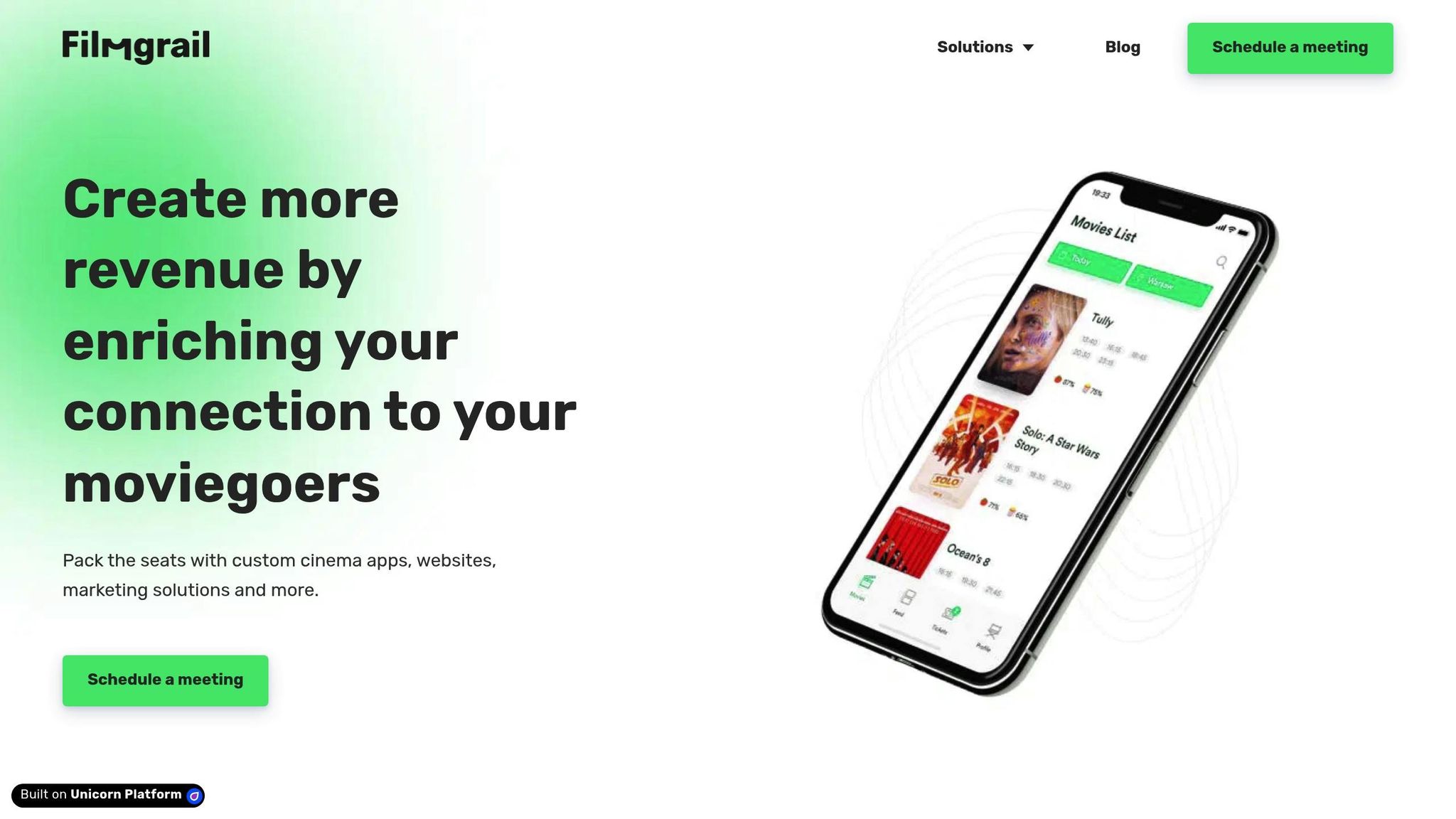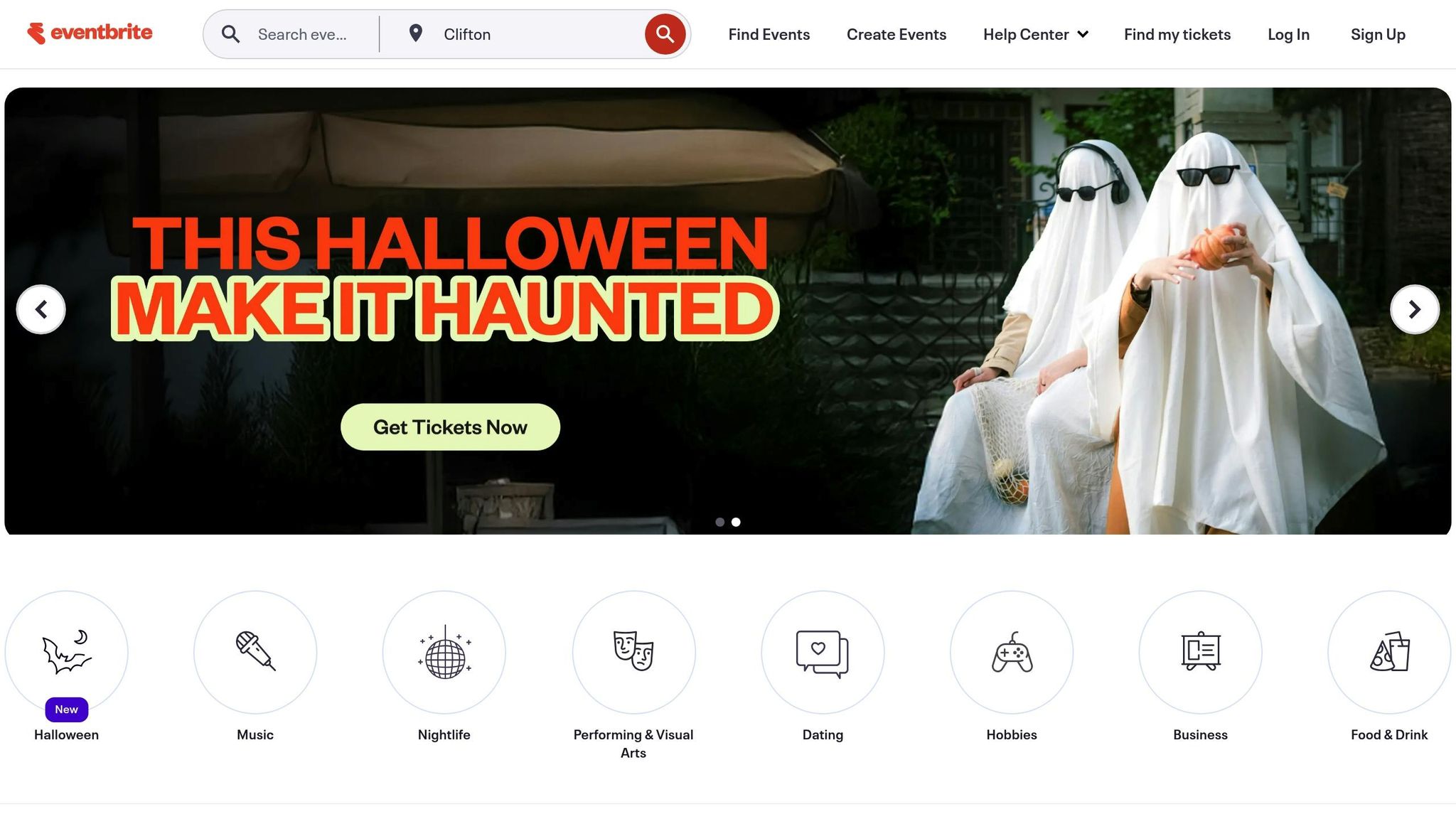Interactive seat selection tools have transformed how people book movie tickets. These platforms let customers visually choose seats, check real-time availability, and ensure accessibility, all while helping cinemas boost ticket sales and optimize seating. Here’s a quick look at the top tools:
- Filmgrail: Combines seat selection with engaging features like trailers and notifications. Users report an 89% increase in digital ticket sales.
- Eventbrite: Simple, pay-per-ticket model ideal for smaller venues. Easy setup but lacks advanced integrations.
- Ticketmaster: Offers dynamic seat maps, real-time updates, and broad exposure. Great for larger chains.
- SeatGeek: Focuses on mobile-friendly tools with clear seat visuals and customization options.
- Seats.io: Flexible design for complex layouts, with a subscription-based pricing model.
- 3D Digital Venue Visualization: Provides immersive 3D maps for a premium booking experience.
These tools cater to different needs, from small indie theaters to large chains, with features like ADA compliance, real-time updates, and pricing flexibility. The right choice depends on your cinema's size, budget, and technical setup.
Build a Movie Seat Booking App using JavaScript - JavaScript Beginner Projects
1. Filmgrail Interactive Seat Selection

Filmgrail brings an interactive seat selection feature to its cinema platform, enhancing the movie ticket purchasing experience while increasing audience engagement and ticket sales. Unlike basic ticketing systems, Filmgrail combines seat selection with engaging elements like auto-playing trailers, video stories, and tailored push notifications, creating a more immersive process for moviegoers.
Real-time Seat Availability and Updates
Filmgrail's system delivers real-time updates on seat availability, ensuring customers always see the most current seating options. No more frustration from selecting a seat only to find it’s already taken - the platform immediately reflects changes as they happen.
This instant synchronization solves the common issues of static ticketing systems by keeping seat status updated across all channels. The result? Theaters can efficiently fill seating gaps, avoid double bookings, and maintain customer trust. For operators, this means improved inventory management and a clearer understanding of seating trends. By analyzing which seats sell first, theaters can make smarter decisions about pricing and auditorium layouts.
Integration Options with Cinema Platforms
Filmgrail's real-time capabilities integrate seamlessly with existing cinema systems. Its API and plug-ins sync seat inventory, ticket sales, and customer data across point-of-sale systems, websites, and mobile apps, ensuring smooth operations.
Designed to support both web and mobile platforms, the system adapts to the technical needs of various cinema sizes. It’s compatible with popular cinema management systems in the U.S., which means theaters don’t need to overhaul their entire setup. This makes it especially appealing to independent theaters and regional chains that rely on specific POS or management software.
Advanced Visualization Features
Filmgrail offers interactive seat maps that make it easy for customers to choose their preferred seats. Clear visual cues - like color-coded indicators - show seat availability, reserved spots, and accessible seating areas, simplifying the selection process.
Theaters can customize these maps to reflect their exact auditorium layouts, including premium and accessible seating sections. This ensures customers see an accurate representation of the theater when booking online.
Accessibility is a key focus. The platform allows cinemas to highlight wheelchair-accessible spaces and companion seating directly on the map, making it easier for patrons with disabilities to reserve suitable seats. This feature supports compliance with the Americans with Disabilities Act (ADA), ensuring inclusivity.
The interface is designed to work seamlessly across devices, whether customers are using smartphones, tablets, or desktops. This responsive design guarantees a consistent and user-friendly experience, no matter how tickets are purchased.
Pricing Models Relevant to U.S. Cinemas
Filmgrail’s pricing model is designed to meet the needs of U.S. cinemas, offering flexibility based on theater size and requirements. Pricing is available in U.S. dollars and tailored to fit the budgets of both small, independent theaters and large chains.
Options include monthly subscription fees, per-ticket transaction charges, or enterprise licensing agreements. This variety ensures that even smaller theaters can access the same advanced technology without facing steep upfront costs.
For specific pricing details, Filmgrail offers personalized quotes through their sales team. This approach ensures that each theater gets a pricing plan aligned with its ticket volume, number of screens, and desired features. With scalable options, theaters of all sizes can implement cutting-edge seat selection tools without breaking the bank.
"Filmgrail has played a determining role in helping us grow our mobile presence and providing an outstanding moviegoing experience beyond the big screen." - Daniel Eikeland, Sales & Service Manager, Bergen Kino
2. Eventbrite Reserved Seating Tool

Eventbrite's reserved seating tool provides cinemas with an interactive way for customers to select their seats. Operating on a pay-per-ticket model with no upfront costs, it allows theaters to improve their ticketing experience without requiring significant initial investments. This setup makes it particularly appealing for smaller venues looking for a straightforward solution.
Real-time Seat Availability and Updates
Eventbrite ensures customers see up-to-date seating options while booking by offering real-time seat availability updates. As reservations are made or canceled, the system refreshes automatically, reducing the chances of double bookings. Its cloud-based infrastructure is built to handle high-traffic situations, making it reliable during peak times like blockbuster releases or special events.
Integration Options with Cinema Platforms
As a standalone platform, Eventbrite doesn't come with built-in integrations for existing cinema POS or management systems. This means theaters, especially larger chains, may need custom development or middleware to connect Eventbrite with their existing setups. However, for smaller venues, this independence can simplify the onboarding process and make it easier to get started.
Advanced Visualization Features
The platform includes interactive 2D seat maps, letting customers visually choose their seats during the booking process. With a drag-and-drop builder, theaters can customize seating layouts to match their specific auditorium configurations. Eventbrite also supports accessibility needs, allowing cinemas to designate wheelchair-accessible and companion seating, ensuring compliance with U.S. accessibility regulations. While it focuses on clear and functional 2D maps, it does not offer advanced 3D visualization features.
Pricing Models Relevant to U.S. Cinemas
Eventbrite uses a straightforward pay-per-ticket pricing model, charging around 2% plus $0.79 per ticket (excluding payment processing fees). There are no upfront costs for basic platform use, and cinemas can choose to either absorb these fees or pass them along to customers. Additionally, the platform provides analytics and reporting tools, enabling operators to monitor ticket sales, seating trends, and customer demographics. These insights can help cinemas fine-tune pricing strategies and optimize auditorium usage.
3. Ticketmaster Interactive Seat Map
Ticketmaster's Interactive Seat Map offers a dynamic way for customers to select seats while providing theaters with tools to manage seating effectively. Here's how it transforms the cinema ticketing process:
Real-Time Seat Availability
The system ensures seat availability is updated instantly, even during busy times. This helps customers find the best available seats quickly and allows theaters to optimize their occupancy rates.
Seamless Integration with Cinema Platforms
Through its powerful API, Ticketmaster's interactive seat map can be embedded directly into cinema websites and mobile apps. Whether it's a single-location theater or a large chain, the system supports centralized reporting, making seat management easier and more efficient.
Enhanced Visualization
The seat map includes features like color-coded sections to show ticket prices and seating areas at a glance. Theaters can also add seat previews or 3D views to give customers a better idea of their viewing angles. Accessible seating is clearly marked to meet U.S. accessibility standards, ensuring inclusivity.
Flexible Pricing for U.S. Markets
Ticketmaster uses a per-ticket service fee model based on sales volume, with enterprise pricing available for larger chains. Additionally, its data insights help theaters understand customer preferences and improve seat selection processes. These tools not only reduce box office congestion but also encourage more online ticket purchases, enhancing both customer satisfaction and operational efficiency.
4. SeatGeek Interactive Seating Charts
SeatGeek applies its event ticketing expertise to cinema venues with interactive seating charts designed for simplicity and clarity. These charts make picking a seat straightforward for moviegoers while offering robust management tools for theater operators. Let’s dive into some standout features like real-time updates, easy integration, detailed visualization, and adaptable pricing.
Real-Time Seat Availability and Updates
With SeatGeek's interactive seating charts, customers can see real-time seat availability as they browse. Open, reserved, and sold seats are clearly marked, ensuring a smooth selection process. This feature is particularly helpful during high-demand showings, giving operators the ability to quickly respond by reallocating seats or adjusting pricing strategies as needed.
Integration with Cinema Platforms
SeatGeek's platform supports flexible API integration, enabling cinemas to embed seating charts directly into their websites and mobile apps. This synchronization ensures that ticket sales, seat selection, and reporting all work seamlessly across systems. It’s designed to cater to both large cinema chains and smaller independent theaters, with tools that allow staff to block seats for maintenance, special events, or accessibility requirements.
Advanced Visualization Features
The seating charts offer detailed and easy-to-navigate auditorium layouts. Color-coded sections highlight different ticket price tiers, and hover-over previews provide additional details, such as viewing angles and amenities. Accessible seating options, including wheelchair-accessible and companion seats, are clearly marked to help theaters meet ADA compliance standards.
Pricing Models for U.S. Cinemas
SeatGeek operates on pricing models tailored to the U.S. cinema market, including per-ticket fees or revenue-sharing agreements. Pricing depends on factors like venue size, ticket volume, and customization needs. Larger chains often have the option to negotiate enterprise-level agreements. Additionally, SeatGeek provides analytics dashboards that let theaters track sales, identify popular seating zones, and fine-tune pricing strategies based on customer behavior.
sbb-itb-b1b0647
5. Seats.io Reserved Seating Platform

Seats.io stands out in the crowded market of seating platforms with its focus on customization and ease of use. Designed with developers in mind, it offers a highly adaptable seat selection system. Its drag-and-drop seat map designer and powerful API have made it a go-to choice for many U.S. cinemas.
Real-Time Seat Availability and Updates
One of Seats.io’s standout features is its ability to provide real-time updates on seat availability - whether a seat is available, reserved, or sold. This feature is particularly helpful during busy booking periods, as it minimizes the risk of double bookings. Thanks to its cloud-based infrastructure, the platform delivers quick and reliable performance, even during high-traffic events.
Integration Options with Cinema Platforms
Seats.io's API and webhook system are designed for seamless integration with existing cinema tools, such as point-of-sale systems, online ticketing platforms, and mobile apps. The platform supports popular payment gateways and cinema software, allowing theaters to maintain their operational workflows with minimal disruption. Comprehensive documentation and integration guides make the setup process smoother for U.S. cinemas.
Advanced Visualization Features
The platform’s interactive 2D maps are designed to handle even the most complex seating arrangements. They can represent curved rows, multiple aisles, and designated accessibility zones with precision. Additionally, wheelchair-accessible seats are clearly marked, ensuring compliance with ADA requirements.
Pricing Models for U.S. Cinemas
Seats.io uses a subscription-based pricing model that adapts to the specific needs of each cinema. Pricing is determined by factors like the number of events, total seats managed, and the complexity of integration. The platform offers both monthly and annual billing options, making it suitable for small independent theaters as well as larger chains. On top of that, Seats.io provides detailed analytics on seat selection trends and occupancy rates, helping theater operators refine their auditorium layouts and pricing strategies to boost customer satisfaction and revenue.
6. 3D Digital Venue Visualization
3D digital visualization takes the moviegoer experience to a whole new level by offering a realistic, interactive view of the theater. This technology allows customers to explore seating options in a three-dimensional space, providing a more immersive way to choose seats compared to traditional 2D maps. By simulating the look and feel of an auditorium, it gives moviegoers a better sense of what to expect, helping them make more confident decisions.
Advanced Visualization Features
The best 3D seat selection tools come with 360-degree auditorium views, enabling users to virtually explore the theater from various angles. This feature helps customers see exactly how their chosen seat fits into the overall layout and sightlines.
Color-coded indicators make it easy to identify available, reserved, and accessible seating. Some platforms even go a step further by including overlays for amenities like premium seating or additional perks.
In addition to static seat maps, some tools offer immersive walkthroughs. These allow customers to virtually navigate the aisles and approach their chosen seats, creating a more engaging and reassuring experience.
Real-Time Seat Availability and Updates
These 3D platforms are synced with cinema ticketing systems to ensure real-time updates. As seats are booked or released, the visualization updates instantly, giving users the most accurate view of what's available at any moment.
Integration with Cinema Platforms
Modern 3D visualization tools are designed to integrate seamlessly with existing cinema management systems. Through APIs and plug-ins, these tools connect with ticketing systems, POS platforms, and mobile apps. Many providers offer compatibility with both iOS and Android devices, ensuring a smooth and consistent experience across desktops, tablets, and smartphones.
The integration process typically involves linking the tool to the theater's seat inventory, pricing systems, and payment gateways. This ensures a streamlined workflow for both customers and theater operators.
Pricing Models for U.S. Cinemas
Pricing for 3D visualization tools is flexible, catering to theaters of all sizes. Many smaller venues opt for monthly subscription plans, which provide predictable costs based on the number of screens or seats managed. These packages range from basic options for single-screen theaters to more comprehensive solutions for larger operations.
For cinemas with fluctuating attendance, per-ticket transaction fees can be an appealing alternative. This model charges based on actual usage, making it ideal for seasonal venues or those with variable demand. Some providers also offer tiered pricing models, where basic plans include standard 3D maps and real-time updates, while premium tiers unlock features like enhanced seat previews, custom branding, and analytics dashboards.
Investing in 3D visualization technology not only enhances the customer experience but also helps theaters optimize seat utilization. By better understanding customer preferences, theaters can make informed decisions about layouts and improve overall satisfaction.
Feature and Pricing Comparison
Building on the platform-specific features discussed earlier, here's a side-by-side look at how these tools address cinema needs in terms of functionality and cost. Picking the right interactive seat selection tool means understanding how each platform measures up in features, pricing, and setup requirements. Each tool brings unique strengths, making them a better fit for certain types of cinemas and business models.
Feature Differentiation Across Platforms
Filmgrail takes the lead in audience engagement, boasting 4 times more moviegoer interaction compared to industry averages. Its standout features include custom branding, auto-playing trailers, and local reviews, all of which help cinemas gain deeper insights into their customers and create personalized marketing strategies.
Eventbrite's Reserved Seating Tool shines with its ease of use and quick setup, making it an excellent choice for smaller venues or those hosting special events. Ticketmaster's Interactive Seat Map offers broad marketplace exposure with advanced filtering options, while SeatGeek focuses on a seamless mobile experience with seat preference tools. Seats.io provides flexible seat map customization and API access, catering to venues with unique layouts. For premium theaters, 3D Digital Venue Visualization tools elevate the experience with immersive 3D seat previews.
Now let’s dive into how these features align with their pricing structures, particularly for U.S.-based cinemas.
Pricing Models and U.S. Market Costs
Pricing varies based on features and the platform’s business model. Platforms like Eventbrite and Ticketmaster charge per-ticket fees ranging from $0.50 to $2.00, making them a good fit for venues with variable attendance. For those preferring a predictable expense, monthly subscription plans are available, starting from $100 to $500 depending on venue size and feature needs.
Filmgrail offers a custom pricing approach, including a free personalized cost assessment and a three-year return on investment estimate. Cinemas using Filmgrail report an 89% average increase in digital ticket sales annually. For 3D visualization tools, tiered pricing models let venues choose between basic plans covering standard features and premium tiers that unlock analytics, custom branding, and enhanced seat previews.
Integration Complexity and Technical Requirements
Integration requirements vary widely. Eventbrite and SeatGeek are some of the easiest to deploy, often needing minimal technical resources to get started. Filmgrail also offers smooth integration, designed specifically for modern cinema operations.
Platforms like Ticketmaster and 3D Digital Venue Visualization tools provide APIs and SDKs for integration with existing POS and CMS systems. For cinemas requiring custom branding or analytics, having in-house IT support or assistance from the vendor during setup is often beneficial. These integration factors play a key role in determining how efficiently the platform performs in day-to-day operations.
U.S.-Specific Localization and Compliance
All major platforms are equipped to handle U.S.-specific requirements, such as USD currency formatting, MM/DD/YYYY date formats, and ADA accessibility compliance. Filmgrail and Seats.io go a step further by enabling custom seat labeling and incorporating local regulations, ensuring a smooth experience for American audiences.
Ultimately, the best choice depends on your cinema's priorities - whether it’s simple event ticketing, in-depth customer engagement, advanced customization, or a premium 3D experience. Each tool is crafted to meet the needs of different market segments, with pricing and technical demands scaling to match. This comparison highlights how these solutions align with operational standards for U.S. cinemas.
Conclusion
Choosing the right interactive tool can make a huge difference in your cinema’s success. These platforms not only improve customer satisfaction but also significantly increase revenue. For example, theaters using engagement-driven tools like Filmgrail have seen an average 89% boost in digital ticket sales annually.
Interactive seat selection has transformed the traditional ticketing process. Giving customers more control enhances their confidence and encourages them to return, creating a lasting edge over competitors.
But the benefits go beyond just selling more tickets. These tools deliver valuable data insights that help cinemas fine-tune pricing, run targeted promotions, and optimize seating arrangements. Features like filling seating gaps automatically or upselling premium seats during the booking process unlock revenue opportunities that older methods simply can’t match. These operational improvements also pave the way for exciting future developments.
Speaking of the future, new technologies are poised to take seat selection to the next level. Artificial intelligence could soon recommend the best seats based on individual preferences, while virtual reality might allow customers to preview their view before making a purchase. These advancements could redefine how audiences engage with the booking experience.
For cinemas in the U.S., the key is finding a tool that’s quick to implement, scalable, and aligned with both current operations and future growth. The right solution can support your theater’s goals today while preparing it for tomorrow’s innovations.
FAQs
How do interactive seat selection tools make the moviegoing experience better for customers?
Interactive seat selection tools transform the process of picking movie seats into a smooth, visual, and hassle-free experience. They give customers greater control by displaying real-time seat availability, making bookings quicker and more straightforward while cutting down on potential confusion or delays.
These tools go a step further by connecting seamlessly with digital platforms like mobile apps and websites. Features such as auto-playing trailers, tailored notifications, and audience reviews add an extra layer of excitement and interactivity, making the overall experience more enjoyable. This not only boosts customer satisfaction but also encourages loyalty.
What should cinemas consider when selecting an interactive seat selection tool?
When selecting an interactive seat selection tool, cinemas should focus on features that deliver a smooth and enjoyable experience for their customers. Key elements to look for include easy-to-use navigation, real-time updates on seat availability, and visually clear layouts that simplify the seat selection process.
It’s also important to evaluate how well the tool works with your current systems, like ticketing platforms and mobile apps, to ensure a hassle-free checkout experience. Improving the user experience not only boosts customer satisfaction but can also lead to increased ticket sales and repeat business.
Why are real-time seat availability updates important for both moviegoers and cinemas?
Real-time seat availability updates play a key role in ensuring customers have the most accurate, up-to-date information when booking tickets. This allows moviegoers to confidently select their preferred seats without the frustration of outdated options or potential errors, making the booking process smoother and more enjoyable.
For cinemas, these updates are equally beneficial. They help optimize seat management by minimizing the risk of overbooking and ensuring maximum occupancy. This not only simplifies operations but also increases revenue while enhancing the overall experience for customers, creating a win-win for both theaters and their audiences.


